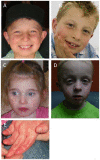A genotype-first approach for the molecular and clinical characterization of uncommon de novo microdeletion of 20q13.33
- PMID: 20805988
- PMCID: PMC2929201
- DOI: 10.1371/journal.pone.0012462
A genotype-first approach for the molecular and clinical characterization of uncommon de novo microdeletion of 20q13.33
Abstract
Background: Subtelomeric deletions of the long arm of chromosome 20 are rare, with only 11 described in the literature. Clinical features of individuals with these microdeletions include severe limb malformations, skeletal abnormalities, growth retardation, developmental and speech delay, mental retardation, seizures and mild, non-specific dysmorphic features.
Methodology/principal findings: We characterized microdeletions at 20q13.33 in six individuals referred for genetic evaluation of developmental delay, mental retardation, and/or congenital anomalies. A comparison to previously reported cases of 20q13.33 microdeletion shows phenotypic overlap, with clinical features that include mental retardation, developmental delay, speech and language deficits, seizures, and behavior problems such as autistic spectrum disorder. There does not appear to be a clinically recognizable constellation of dysmorphic features among individuals with subtelomeric 20q microdeletions.
Conclusions/significance: Based on genotype-phenotype correlation among individuals in this and previous studies, we discuss several possible candidate genes for specific clinical features, including ARFGAP1, CHRNA4 and KCNQ2 and neurodevelopmental deficits. Deletion of this region may play an important role in cognitive development.
Conflict of interest statement
Figures


Similar articles
-
Terminal 22q deletion syndrome: a newly recognized cause of speech and language disability in the autism spectrum.Pediatrics. 2004 Aug;114(2):451-7. doi: 10.1542/peds.114.2.451. Pediatrics. 2004. PMID: 15286229
-
Clinical and molecular characterization of an emerging chromosome 22q13.31 microdeletion syndrome.Am J Med Genet A. 2018 Feb;176(2):391-398. doi: 10.1002/ajmg.a.38559. Epub 2017 Nov 28. Am J Med Genet A. 2018. PMID: 29193617
-
15q11.2 microdeletion (BP1-BP2) and developmental delay, behaviour issues, epilepsy and congenital heart disease: a series of 52 patients.Eur J Med Genet. 2015 Mar;58(3):140-7. doi: 10.1016/j.ejmg.2015.01.002. Epub 2015 Jan 14. Eur J Med Genet. 2015. PMID: 25596525
-
Microdeletion of 12q24.31: report of a girl with intellectual disability, stereotypies, seizures and facial dysmorphisms.Am J Med Genet A. 2015 Feb;167A(2):438-44. doi: 10.1002/ajmg.a.36872. Epub 2014 Nov 26. Am J Med Genet A. 2015. PMID: 25428890 Review.
-
Phenotypic features of a microdeletion in chromosome band 20p13: A case report and review of the literature.Mol Genet Genomic Med. 2019 Jul;7(7):e00739. doi: 10.1002/mgg3.739. Epub 2019 May 13. Mol Genet Genomic Med. 2019. PMID: 31087544 Free PMC article. Review.
Cited by
-
Further Phenotypic Delineation of Partial Trisomy 17q and Partial Monosomy 20q due to Rare t(17;20).Mol Syndromol. 2020 Feb;11(1):38-42. doi: 10.1159/000505141. Epub 2020 Jan 14. Mol Syndromol. 2020. PMID: 32256300 Free PMC article.
-
Evolution of the human-specific microRNA miR-941.Nat Commun. 2012;3:1145. doi: 10.1038/ncomms2146. Nat Commun. 2012. PMID: 23093182 Free PMC article.
-
Candidate Genes Associated with Delayed Neuropsychomotor Development and Seizures in a Patient with Ring Chromosome 20.Case Rep Genet. 2020 Jan 21;2020:5957415. doi: 10.1155/2020/5957415. eCollection 2020. Case Rep Genet. 2020. PMID: 32082653 Free PMC article.
-
Novel COL9A3 mutation in a family diagnosed with multiple epiphyseal dysplasia: a case report.BMC Musculoskelet Disord. 2014 Nov 8;15:371. doi: 10.1186/1471-2474-15-371. BMC Musculoskelet Disord. 2014. PMID: 25381065 Free PMC article.
-
A novel de novo 20q13.32-q13.33 deletion in a 2-year-old child with poor growth, feeding difficulties and low bone mass.J Hum Genet. 2015 Jun;60(6):313-7. doi: 10.1038/jhg.2015.22. Epub 2015 Mar 12. J Hum Genet. 2015. PMID: 25761574
References
-
- Shaffer LG, Theisen A, Bejjani BA, Ballif BC, Aylsworth AS, et al. The discovery of microdeletion syndromes in the post-genomic era: review of the methodology and characterization of a new 1q41q42 microdeletion syndrome. Genet Med. 2007;9:607–616. - PubMed
-
- Fraisse J, Bertheas MF, Frere F, Lauras B, Rolland MO, et al. [Partial monosomy 20q: a new syndrome. Regional assignment of the ADA locus on 20q132 (author's transl)]. Sem Hop. 1982;58:1366–1369. - PubMed
-
- Aldred MA, Aftimos S, Hall C, Waters KS, Thakker RV, et al. Constitutional deletion of chromosome 20q in two patients affected with albright hereditary osteodystrophy. Am J Med Genet. 2002;113:167–172. - PubMed
-
- Roberts AE, Cox GF, Kimonis V, Lamb A, Irons M. Clinical presentation of 13 patients with subtelomeric rearrangements and a review of the literature. Am J Med Genet A. 2004;128A:352–363. - PubMed
Publication types
MeSH terms
LinkOut - more resources
Full Text Sources
Molecular Biology Databases

